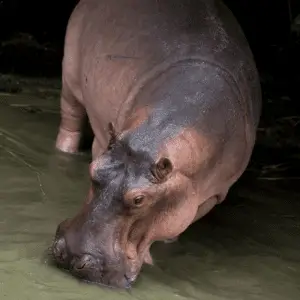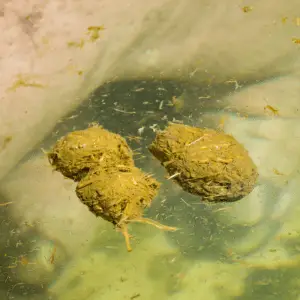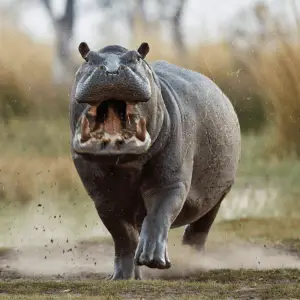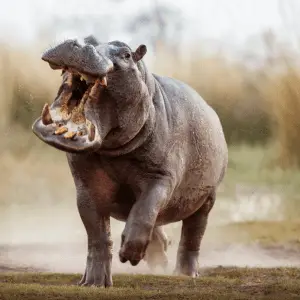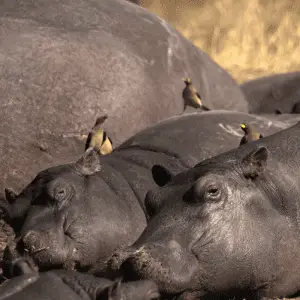The hippo is a fascinating animal, and they’re one of my favourite kinds to watch and learn about because of the wide variety of behaviours.
Why Do Hippos Have Big Teeth?
Even though hippos are vegetarians, they possess large teeth so that they can use them for fighting. Hippos will use their sharp and long incisors to fight against each other and fight off any threat, including humans and other animals.
Hippos are highly aggressive territorial animals. They are, in fact, the most responsible for more human deaths in Africa than crocodiles or lions. The bull hippos fight against each other for dominance of the territory and over the females. Their large, sharp teeth help them intimidate and fight their opponents successfully.
What do hippos eat?
Hippos are herbivores. They mainly eat leaves, grass, fruits, ferns and roots of plants. Hippos can eat about 80 pounds of vegetation each night and travel up to 6 miles to find food.
The unique feature of a hippo is that when food is scarce in the dryer months, hippos can store food in their stomach and live without eating for about three weeks.
Even though hippos are defined as herbivores, they can also feed on the carcasses of other animals, including their species. Still, this behaviour does not frequently occur, usually in desperation.
Do hippos have molars?
Yes, hippos have molars located in the back of their mouth. Even though the incisors and canines are more attention-grabbing, the molars play a crucial role in consuming regular food.
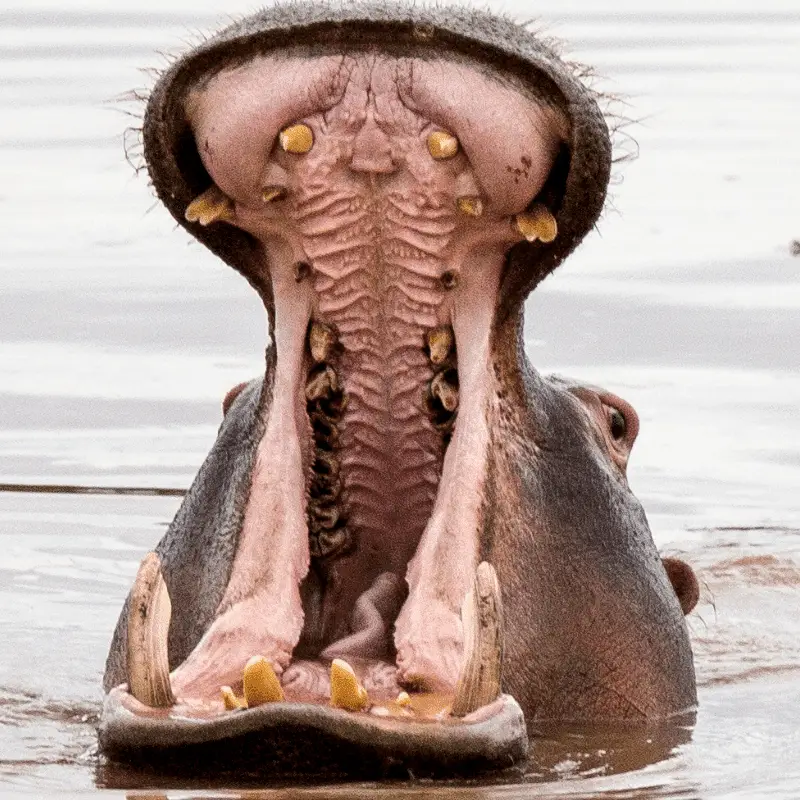
Hippo Teeth
Just like humans, hippopotamuses also have four different types of teeth in their mouths. That means you can see incisors, premolars, molars, and canine teeth in a hippo’s mouth.
The adult hippo has about 36 teeth in its mouth.
Among all these teeth, most of them are premolars and molars. An adult hippo can have 28 molars and premolar teeth at the back and the sides of its mouth.
The front of the mouth of the hippo has canine tusks and sharp incisor teeth. Even though hippopotamuses are primarily herbivorous, they use these teeth as a defensive tool. Also, hippos often showcase their incisors and sharp canine teeth to establish dominance over other hippopotamuses and animals.
This aggressive display of teeth is typical behaviour that you can spot among hippos. The premolars and molars are flat teeth that these animals often use for grinding and chewing food. The function of hippos’ premolar and molar teeth is the same as humans.
Chewing
The premolars and molars play a significant role in hippos’ ability to eat food. The amount of food the molar and premolar teeth help grind up is not small. Every day an adult hippo can consume about 35 kgs of grass and other plant bodies.
Even though hippos are vegetarians, they sometimes scavenge on the carcasses of other animals or hippos. However, this is not typical behaviour. Hippos mostly showcase this kind of behaviour during extreme cases of hunger.
Grass, other vegetation, and fruits are the primary food source of the hippos. The hippos have giant mouths, and they use their lips to grab on grasses and shake their head to tear them off the ground.
Once the grass and other plant body are inside its mouth, the hippos use molars to chew. Hippos keep chewing on the grass and other plant bodies until it becomes mashed, which is easy enough to swallow.
Wear and tear
Just like the elephants, the incisors and canine teeth of the hippopotamus grow throughout its life. The length of the canine tusks of the hippopotamuses can reach up to 3 feet in length. However, the hippopotamus’ molars and premolars do not keep growing throughout their life.
Like humans, the molars and premolars of the hippopotamus are incredibly susceptible to wear and tear from grinding down the food.
Even though these teeth are covered with enamel, which makes them stronger, over the period, these teeth become too worn out to use.
After these teeth become worn out, the hippos can no longer consume food, so they cannot eat. As a result, most of the time, hippos die due to starvation. However, this is mainly in the old-aged hippos.
Ivory
If you think only elephants are being threatened for ivory, you are gravely mistaken. In Africa, hippos are often hunted by poachers for their teeth. Hippo meat and skin are equally pricey, so people often kill these gigantic animals.
Once they get these teeth in their hand, they remove the enamel as the ivory rests under it. Compared to the elephants, the ivory of the Hippopotamuses is denser and less responsive to decay. Together, this makes hippo ivory even more lucrative to the poachers.
Even though you can still see several hippos in east and central Africa, the number of animals in the wild is getting lowered each day.
Conservationists are trying very hard to protect these gigantic animals from illegal hunting and human-animal conflicts that affect their natural habitats significantly.
Are Hippos Endangered?
Undoubtedly, the number of hippos in the wild has dropped significantly in the last few years. Even though hippos can be seen quite frequently in East and Central Africa, their numbers have been down for some time now.
The common hippopotamus is named in the vulnerable category, while the Pygmy Hippo has enlisted in the endangered species list. Even though hippos do not have any natural predators, both species are being threatened by illegal hunting and human-animal conflict.
Common Hippopotamus
The common hippopotamus, amphibious, is the second-largest land animal. These gigantic animals have been put on the vulnerable list since early 2008.
The number of these animals in the wild has suffered significantly in the last couple of decades. From 1902 to early 2000, the number of hippos in the wild declined sharply.
You can find these enormous animals in most of Sub-Saharan Africa, with natural lakes and rivers. Most of these animals stay in the water to keep their body temperature under control during the daytime. These animals go in search of food during nighttime.
These animals of colossal size and extreme affinity for water have gained another name, the water horse. Even though these animals do not resemble a horse, their name goes perfectly with their behaviour.
Hippos are considered land animals; however, their more amphibious type animals. Hippos are more closely related to dolphins, whales, and porpoises.
The Red List assessment has declared that the number of hippopotamuses roaming in the wild is about 1,15,000 to 1,30,000, considerably lower than the 1,48,000 hippos counted in 2008.
Even though this downward spike is significant, it is not enough to put these animals in another risk category. There may be some miscounting of hippopotamuses in certain African countries in 2008.
However, recent evaluations still state that the situation of the hippopotamus in the world is precarious. It requires direct intervention and conservation actions to ensure that these animals do not vanish from the face of the earth.
The hippopotamus population has stabilised in several African countries, but the incidents regarding habitation loss and unregulated hunting are still high.
Pygmy Hippopotamus
The Pygmy Hippopotamus became enlisted in the dangerous species list in early 2010. In the last couple of decades, the number of Pygmy Hippos has significantly decreased. The problem is there are only about 2000 pygmy hippos left in the wild.
The surveys and cameras evidence in African countries like Liberia still shows proof of a small number of hippopotamuses.
The original forest habitat of the Pygmy hippos has already been significantly destroyed by agriculture, logging, mining, and commercial palm oil plantation.
The conservationists think the increased level of hunting activity and habitation loss has resulted in this significant losses among significant hippos. The statistical data indicates that the number will decrease by 20% or more in the next 26 years if the proper steps are not taken.
Interesting Facts About the Hippopotamus
- There are two species of hippos that you can find in the wild. Both the common hippo and the Pygmy hippo require the restorative cooling properties of muddy water to live a healthy life.
- You will often find hippopotamuses lounging in the lakes or rivers while keeping their bodies almost fully submerged.
- The hippopotamus’s skin is very thick; however, it is very susceptible to sunburn. Hippotumuses can lose significant water and become dehydrated if they stay out of the lake or river for too long.
- The common hippo likes to stay in larger groups, the Pygmy hippos are solitary animals and prefer to stay on their own or with another. You can find a couple of Pygmy hippos living together, forming a much smaller group than the common hippopotamuses.
Third-Largest Land Animal
Apart from the elephants and the white rhino, hippos are the third-largest land animals. An average fully-grown common hippopotamus can reach up to 7000 pounds in weight.
The baby hippos are also not very small when they are born. At birth, the baby hippos weigh about 60 pounds. A Pygmy hippo can reach up to 600 pounds in weight. However, it does not take them a long time to gain weight. The baby hippo can become a mature adult only in three and a half years.
How heavy are Pygmy hippos?
Pygmy hippos are ten times lighter than normal-size hippos. They can weigh between 352 and 605 pounds.
Hippopotamuses Cannot Swim
Even though these magnificent animals are known as river horses, they cannot swim themselves. However, these animals spend most of their time lounging in the rivers or lakes.
Hippos can immerse themselves entirely or only keep their eyes and ears showing on the river’s surface for hours. However, most of the time, the hippopotamuses stay in shallow waters. When moving in the water, hippos tend to walk on the river or the lake bed instead of swimming. Even though they cannot swim, the hippos use their unique body structure and buoyancy to move quickly in the water. Hippopotamuses can move at eight mph speed underwater.
Recommended Read: Can Hippos Swim?
Baby Hippos
Hippopotamuses are vegetarians and nocturnal animals. Most of the time, hippos come out of the water only at nighttime, searching for food. However, the baby hippos’ diet is different from the adults.
During the first six months of their life, the babies depend entirely on their mother’s milk. Once the babies are born, they stay very close to their mothers, relying on food and protection. Even though the baby hippos start to graze after one month, they do not eat vegetation entirely until they are six months old.
Baby hippos can feed both underwater and on dry land. While nursing, the babies can maintain this position for a long-time.
Hippo milk is pink only because it gets mixed with the sweat from a hippo mother. It’s not pink but a whitish-yellow colour at first.
The Eyes, Ears and Mouth: Special Hippo Feature
The lack of swimming skills of the hippos gets managed by their ability to hold their breath underwater for an extended period. While these gigantic animals submerge themselves, they use thick membranes to close up their nostrils and eyes.
This membrane helps create a protective waterproof seal over their eyes so that the hippo can see underwater without any problems. Whenever the hippos feel threatened or want to move to another area, they close their nostrils, eyes, and ears and go underwater.
Another exciting feature is that hippos can even sleep underwater with the help of this unique reflexive instinct.
Hippos Are Very Vocal
Even though it may not seem likely, hippos are very vocal animals. They use various types of noises to communicate with each other. Their sound is very distinct, and they can be described as whines, growls, squeaks, and honks.
Sometimes the sound that the hippos make can resemble the sound of human laughter. You can hear the sound of the hippopotamuses from a mile away.
Hippos have many different sounds to spread messages and communicate with each other. By using various vocalisations, hippopotamus may alert other hippos of a threat or danger or even call their young.
Hippo Groups
Even though Pygmy hippos love to spend their lives solitary or just with one, the common hippos are often found in larger groups. At times, these groups can consist of over a hundred hippos.
Hippo Predators
The main predators of a hippo will try to hunt down an adult hippo. Although most of the time, these predators target the week-old and injured Hippopotamuses vulnerable to an attack. These predators often attack baby hippos, especially if they wander off from the protection of their mother. Living in a large group helps the common hippos to stay safe and secure from threats.
- Crocodiles
- Lions
- Spotted hyenas
Humans are also a threat – people have hunted hippopotamus for their meat and ivory teeth.
Mating
A female Hippo can give birth to babies every two years. Even though hippos do not have any particular mating season, their mating takes place in the water most of the time. During mating, the female and the male water hippo will use body language and vocalisations. They use their faeces and urine to showcase interest. Hippos will travel into the territory of other males. That is why only the dominant and powerful male hippos get to breed.


